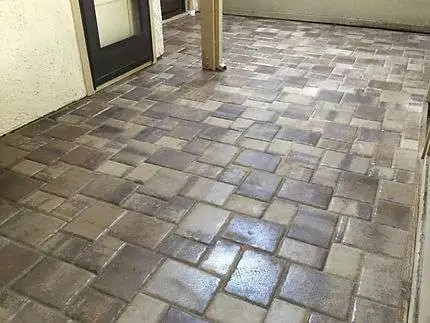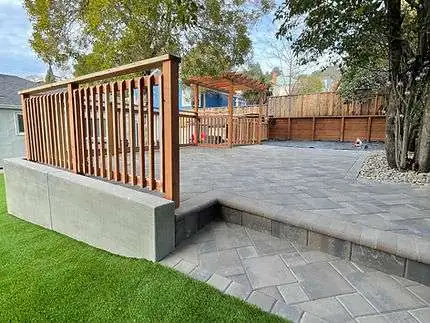What Are Large Pavers?
Large pavers are exactly as the name implies. It is a bigger version of regular patio pavers or concrete blocks. Large pavers come in sizes of 24×24, 30×30, 24×36, 18×36, and 48×48. The materials of a large paver patio are usually porcelain, stone, or concrete, in the case of cheaper prices. These offer a high-end look, which instantly uplifts a home’s patio outlook.
Are Large Pavers Good for Patios?
Large pavers are on hype in outdoor design. But are they actually good for patios? The short answer is yes. Let’s take a look at why large pavers are complemented by everyone-
- Modern, upscale appearance
Large pavers instantly elevate an outdoor space with a clean, spacious feel. They pair perfectly with Bay Area architectural styles from Silicon Valley tech-modern to Marin minimalism. - Makes small patios look bigger
Fewer joint lines = less visual clutter. This is especially effective for tight city backyards in SF or Oakland. - Durable with proper base prep
When installed correctly, large slabs offer excellent stability and long-term performance. - Easy to integrate with outdoor features
Fire pits, outdoor kitchens, pergolas, and seating walls all complement large-format designs.
Considerations to Keep in Mind
- Large slabs require more precise base preparation, especially on clay-heavy or sloped terrain.
- They’re heavier and need experienced installers for leveling.
- Not all large slabs are suitable for driveways; look for load-rated options if needed.
Overall, large pavers are an excellent choice when installed by professionals who understand Bay Area soil dynamics.

Are Large Pavers Cheaper Than Concrete?
Large pavers usually cost more than concrete up front, but they often save money long-term. Here is a cost breakdown-
Here’s why concrete seems cheaper:
- Material costs are lower. Concrete is cheaper to produce than other materials like stone and porcelain.
- Installation is faster since it’s poured and finished on-site. The concrete layers easily cover up the space at a faster rate.
But here’s the downside for Bay Area homes:
- Concrete cracks, especially in areas with expansive clay soils.
- Repairs often require replacing full sections.
- Stains and discoloration happen quickly in fog-prone or shaded areas.
Why large pavers offer better long-term value
- You can replace the Individual units of large pavers if needed.
- More resistant to cracking when installed with a properly compacted base. In this way, large pavers offer more durability than regular materials.
- Many options are stain-resistant, especially porcelain and well-sealed concrete slabs.
- Aesthetically, they maintain a high-end look for years. Large paver gives a wow-factor to your home, increasing resale value and curb appeal
So while poured concrete might win on initial cost, large pavers usually win on durability, appearance, and maintenance savings.
Large Patio Paver Ideas on a Budget
- Mix Large Pavers With Gravel
Use large slabs as “islands” within gravel. This reduces the number of pavers needed and gives a sleek, European courtyard feel. Works especially well in drought-friendly Bay Area yards.
- Choose Standard 24×24 Concrete Slabs
They’re typically the most affordable large-format option and widely stocked in the Bay Area. Simple square grids look modern without expensive cuts.
- Create a Minimalist Grid Layout
A perfectly spaced grid pattern looks high-end but is cheaper because it avoids complicated cuts and uses fewer materials overall.
- Use Large Stepping-Stone Setups Instead of Full Coverage
Perfect for patios that connect to gardens or side yards. Large slabs spaced apart save money while still giving a clean, intentional design.
- Pair Large Slabs With Artificial Turf Strips
Turf joints between slabs create a luxury look at a lower cost. This also reduces the amount of concrete or stone you need.
- Blend Large Pavers With Decorative Rock Beds
Bordering your patio with river rock, lava rock, or crushed granite reduces the number of slabs needed while adding a custom feel.

Large Patio Paver Ideas for Small Areas
Smart, Small-Space Strategies
- Use light-colored slabs to brighten shady areas in SF, Mill Valley, or Oakland.
- Choose fewer, larger pieces for a seamless look.
- Combine slabs with artificial turf to visually expand the space.
- Create a grid courtyard feel, perfect for small backyard lounges.
Great Layout Choices
- 24×36 staggered pattern to elongate narrow yards.
- 24×24 square grid for a clean contemporary look.
- Floating slabs with gravel for a modern Zen-style courtyard.
Planning Tips for Large Patio Pavers
- Prioritize drainage, especially before the rainy season. This will avoid any waterlogging in your patio.
- You must check for soil movement in hillside or clay-heavy areas before installing large pavers.
- Ensure access for large slab delivery, some weigh over 100 lbs.
- Match colors to your home’s architecture for a cohesive look.
- Consider edging, lighting, and planting to complete the space.
Conclusion
Large Patio Pavers offer stylish, durable, and low-maintenance outdoor upgrades you can make. In the Bay Area, where climate and soil conditions demand smart materials, large pavers are the perfect choice. With professional installation, they can completely transform both large and small outdoor spaces.
If you’re ready to explore large-format paver options tailored to your home, GLscapes Inc. offers expert design and installation services built specifically for Bay Area landscapes. We’re here to help you create a modern patio that looks incredible and lasts for years.
Contact us today to schedule a consultation and start designing your dream outdoor space!
